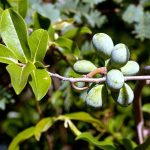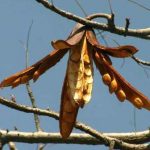TREE LIFE
August 1985
MASHONALAND CALENDAR
Saturday August 3rd: Botanic Garden Walk at 1100 hours to look at the South East Lowveld section as a preview for Gonarezhou.
Friday – Tuesday, August 9th – 13th:Gonarezhou Trip. Please note Tuesday is not a public holiday, ministerial confirmation, despite what your calendar may say. So please organize leave. We will compile a separate note for all those going. Any questions please phone Phil 8871413.
Thursday August 15th: Father Watsham of St Ignatius School will be delivering a talk on “The Ecology of Fig Wasps” at the Department of Biological Sciences, University of Zimbabwe at 1600 hours. Having seen these little wasps inside the figs at the Mar-Levins last month, this talk should be very interesting. Father Watsham has identified at least 28 species of wasps inside the figs of F. thonningii and has published many of these exciting findings in international literature. Tea will be served at 1530 hours in the Biology Reading Room.
Sunday August 18th: Mukuvisi Woodlands Foot Safari. The Mukuvisi Woodlands Association has very kindly invited the Tree Society to join their Foot Safari. We should meet in the car park near the office at 0900 for 0930 hours. Mr. Geoff Keeling who is plant orientated will be our guide. We are sure many members have seen these safaris advertised and have always meant to join one. We would like to thank the Mukuvisi Woodlands Association for giving us this opportunity.
MATABELELAND CALENDAR
Sunday August 4th: We will go to the area BEYOND Whitestones. Meet at 0830 hours at the Junction of Northway and Burnside Road.
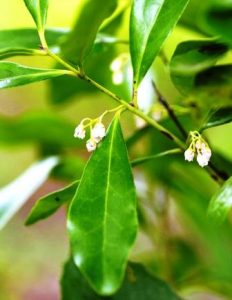
Euclea racemosa subsp. schimperi. Photo: Bart Wursten. Source: Flora of Zimbabwe
On Sunday 7th July we went to the Matopos to the area near the Moth Shrine and the Mtsheleli Valley. In the intervals of locating Black Eagles and their nests, past and present, we identified some 50 trees that morning. Among the more interesting were, Acokanthera rotundata, one in particular had a most attractive deep purple red new leaf, Allophylus africanus, hairy armpits not very visible, Diospyros mespiliformis, which we have confused in the past with Mimusops, but not today, Euclea racemosa subsp. schimperi, with its glossy green leaves, Faurea saligna, only rather small specimens, Heteropyxis dehniae, which sent us all a-sniffing the crushed leaves for lavender, Homalium dentatum, apparently this, owing to its long branch free bole, is a preferred nesting site for the African Hawk Eagle, Lonchocarpus capassa, in very full leaf, Maytenus heterophylla, much smaller leaved, spinier and finer than those of Bulawayo District. Mimusops zeyheri, Pavetta elyesii, with peeling bark, faintly rather delicate young growth, Schrebera alata, Strychnos matopensis, in large bushy clumps, in many rocky areas, and Terminalia randii, which hardly seems to be a Terminalia, with spines all over and plum coloured leaves just now.
-C. Sykes
BOTANIC GARDEN WALK, 6TH JULY 1985 : THE MYRTALES
Tom jokes about our latest ALES walks, the Urticales, the Malvales and now the Myrtales. We don’t seem to be content with simple families. Nevertheless he was happy to show us around this order of plants which contains six indigenous tree families, according to friend Cronquist, I hasten to add. We looked at the THYMELIACEAE, the MYRTACEAE, Gum family, and the OLINIACEAE. Also in this order are the LYTHRACEAE, Pride of India, MELASTOMATACEAE, Tibouchina and COMBRETACEAE which we did not look at. All of these families have simple leaves with entire margins and usually lack stipules. They are mostly opposite, except for Peddiea, Heteropyxis and Terminalia.
We began by looking at the MYRTACEAE, a family we associate with the smell of their crushed leaves, relate in you mind the smell of Syzygium, of gums, of guavas, Psidium, or Heteropyxis. What would mulled wine be like without the dried flower buds of Syzygium aromaticum, cloves, or a dash of Pimento divica, allspice, or more appropriately, who would ever drink some of our homemade wines without these? This smell is due to ethereal oils in secreting cavities within most of the plant’s non-woody tissue. The genus Syzygium seems to be in a confused state. The first tree was S. gerrardii, or S. quineense subsp. gerrardii, or S. quineense subsp afro-montanum, so take your pick. This little tree alongside Grewia occidentalis showed the distinctive red, young leaves and often a blue tinge to the older leaves. The 4-angled young branchlets were almost winged. Tom says the pale barked, buttressed trunk has a coffee brown slash, memories of café au lait on the Parisian street walks flood back. This species grows to well over 20m in the Bunga and above the tea estates in Inyanga where it grows with Bequaertiodendron. It is also found in drier forests around Domboshawa, although Tom took us to his specimen alongside the Harungana which is more like the like a gum. We then compared this with G. guineense subsp. quineense growing alongside it. Here the leaves are more obovate and the bark is rougher as we would expect from a woodland species, although it also grows alongside vleis. This subspecies includes the very large fruited specimens around Bindura. The next tree in this forest was yet another possible species, S. owariense, which had enormous, rounder leaves and is found in the lower streams of the eastern District where it grows to 40m along streams. Some taxonomists lump this with the preceding specimen despite the obvious differences in vegetative characters. Wondering over to the Hyphaene grove we saw S. quineense subsp. barotsense with very pale bark. The fruit, when ripe, is large and has been known to distract many a botanic garden walk. This riverine species grows at Victoria Falls and possibly along the Lundi. Taxonomy is complicated by hybrids with S. cordatum.
Entering the forest we found Eugenia woodii (E.sp. no. 2 = E. capensis subsp. natalensis) of the Natal rain forests and the Makurueni forest where it is an under storey tree. We found large fruit on this female tree. Eugenia looks very similar to Syzygium and both have a sub marginal vein around the leaf, a common feature throughout the family and also in the OUNIACEAE. Alongside the Anniqeria we saw Eugenia nyassensis (=E. capensis subsp. nyassensis) at the high and medium altitudes in the Eastern Districts where it attains a height of 15m. I am sure I would muddle it up with Olinia if I saw only a small twig. We saw plenty of Olinia vanquerioides at the Marr-Levin’s this month and were struck by the flaking bark and sub marginal veins which help to tie it into the Myrtales, but they are in another family, the OUNIACEAE. Georgie swears by the reddish touch to the leaves and petioles. Olinia is a forest outlier in the Chimanimani and Cashel Valley. Jumping back to the walk again we crossed to the Eastern Highlands forest to find another MYRTACEAE, although it used to once be in the HETEROPYXIDACEAE, Heteropyxis dehniae. This is characterized by its smell, the alternate leaves and the slight bumps in the axil of the leaf vein. It was interesting to compare its bark with that of Olinia, they both have similar slakes. It is of a rain forest outlier, common on the Iron Mask range, and can even be found in Helensvale, Harare.
Swopping families we looked at Dais cotinifolia of the THYMEUACEAE. The characteristic feature of most members of this family is a bark which strips easily tearing into long ‘heels’. Dais has been used as a garden ornamental and is most attractive in pink flower. Just within the forest we found another member of the family but a creeper, Synatalepetus kirkii of the Nyoni Mountains. We also examined the crinoid leaves of Passerina montana, a shrub of the same family, common in the Eastern Districts. Near the bottom left of the stream we found Peddia africana in flower. It grows from coastal dune forest to the heights of Inyangani where it becomes more tree like above 2000m it may have a trunk diameter of 15 cm and grows 5 to 6m tall. It has a soft dark berry which I remember from the Vumba. Tom then showed us a prized Eugenia capensis from Haroni Rusitu Valley. The specimen hardly had a dozen leaves.
I am afraid I have not had time to repeat the walk and expand the notes, but it was excellent to see so any of them at Ruwa, including Syzygium cordatum in flower, demonstrating the similarity to a flowering gum.
-Kim ST.J. Damstra
CLEVELAND DAM, 13TH JULY: Botanizing in bitingly cold wind is not easy but the Faurea speciosa were in spectacular bloom. In the shelter of the rocks we heated up like basking lizards and Gill Masterson discovered black ants working actively at the glands on Azanza garckeana leaves. This is the first time I have been shown this on Azanza, although we have seen them on the glands of young leaves in Parinari and Albizia species. The tree diversity at Cleveland is rather remarkable.
-Kim ST.J. Damstra
OUTING TO MARR-LEVINE’S FARM RUWA/GOROMONZI 21ST JULY 1985
Sunday’s outing to John and Jill Marr Levine’s property on the Mashonganyika Road in the area beyond Ruwa overlooking the Nora Valley was very rewarding.
We assembled at the farm house which is perched on the edge of the escarpment of the valley with the result that one gets the most stupendous view to the north from the front lawn. Murehwa is just visible on the horizon. As if that were not enough, Jill laid on the most fabulous welcoming tea What better way to start a Sunday outing?
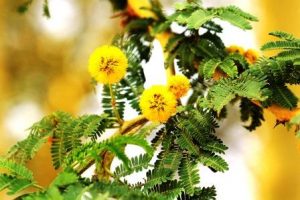
Acacia xanthophloea. Photo: Bart Wursten. Source: Flora of Zimbabwe
The congregation was soon shepherded back to the vehicles and led to our morning venue comprising vegetation along two streams on the lower ground below the house. An early encounter baffled a number of people. This was a young fever tree, Acacia xanthophloea! It turned out to be a cheat for this was a tree planted last year by Jill. How nice to see this young tree growing so strongly so far from home! We soon passed some more familiar Acacias, firstly A. goetzei carrying hooked thorns and relatively large leaflets; secondly A. amythethophylla which is distinguished by having longer leaves than any of our other local acacias, N.B. leaves, not leaflets. The lovely spreading umbrella tree was A. sieberiana.
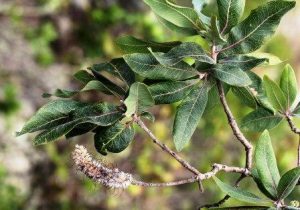
Faurea speciosa. Photo: Bart Wursten. Source: Flora of Zimbabwe
The path, which our hosts had specially arranged to have slashed for our visit, led past a number of Faurea speciosa in new leaf and flower. The veins on the leaf join to form a continuous margin around the leaf. Faurea is in the same family with the Proteas and if one imagines the Faurea flowers concertinaed together rather than stretched out in a catkin the similarity with Protea can well be imagined.
When did we last see Olinia vanguerioides? I think it was more than two years ago and a long way off at Mawari, Palm Block at the northern end of the Great Dyke. Yet here, within half an hour’s drive of Harare was a concentration of these unusual trees on both of the streams and a healthy population to boot with young trees providing evidence of regeneration. The blotchy peeling bark, not unlike that of Heteropyxis, is perhaps the most outstanding feature of this tree, followed closely by the red tinges to the petioles on the opposite leaves. In fact the foliage as a whole has an aura of red about it. Close examination showed that a continuous vein around the leaf margin was present, as was also the case with the leaves of Syzygium seen close by. It was observed that whilst not even of the same family, they both belong to the same order, namely the Myrtales.
We found Carissa edulis in this riverine thicket. Again, I recall this as being a common tree/shrub at Palm Block.
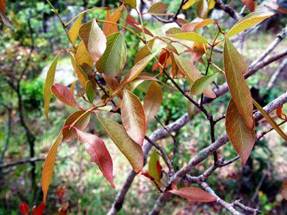
Pleurostylia africana. Photo: Rob Burrett. Source: Flora of Zimbabwe
We were impressed by the large size and local abundance of Pleurostylia africana. Their size and rather droopy leaves misled a number of us into labeling this as Tarenna neurophylla, until the absence of inter-petiolar stipule was detected.
Seemingly out of place in this riverine habitat were Diospyros natalensis and on exceptionally large Dalbergia nitidula. Both are more commonly seen in a kopje habitat
The SAPOTACEAE family was represented by a number of Bequaertiodendron magalismontanum and a Mimusops zeyheri, both of which showed off the family trait of “looping” the horizontal branches, i.e. the branch growing down at a slight angle and then curving up and from this the next year’s growth doing the same, resulting in a series of waves. The folding back of the new leaves was observed on Bequaertiodendron and though not so obvious on Mimusops was nonetheless discernible.
The riverine fringe provided the preferred habitat Rhamnus prinoides, which is distinctively glossy on the upper surface of the leaf, but a dull matt green below. The veins on the under surface are most prominent while, by contrast, they are recessed on the upper surface. These features together with the serrated edge to the leaf should serve to identify this species even if it is without the small red berried.
A pleasing sight was the Pittosporum viridiflorum in full fruit, consisting of small round capsules splitting open to reveal bright red seeds covered in a sticky resin which undoubtedly adheres to visiting fauna and thus achieves dispersal. These capsules hang in bunches in a most attractive display.
Very conveniently Rhoicissus tridentata and R. revoilii were placed cheek to jowl together in the riverine vegetation, no doubt for the sake of easy comparison by Tree Society members. R. tridentata has the very dentate or serrate leaf margin which R. revoilii lacks.
A little removed from the riverine thicket was a remarkable sight. A Rhus leptodictya had assumed the role of a rock splitting fig. I do not jest. Verily, the tree had seeded in a hairline fracture of the boulder and, I believe, had then pried open the rock in the course of growth, to the extent of, say, five centimeters. This was yet another species which had strayed from its more usual kopje domain. This Rhus has narrow, pointed leaflets, though not as long and willow like as those of Rhus lancea. We did not see Rhus lancea but spotted a fair number of Rhus longipes sporting new, fresh apple green leaves which always herald the new season. The leaflets of this tree are, by contrast, very round in shape.
These were for me the highlights of the morning’s walk, although a great many other trees both great and small were admired.
After again ingesting that glorious view and our picnic for lunch on the lawn of the house we set off to see what the kopje behind the house had to offer. The most dramatic offer was that of a magnificent 360o view of the countryside attained after scaling a precipitous steel ladder leading to a beacon sited at the top of the highest granite boulder.
The kopje was home to some truly elegant Brachystegia glaucescens which produced a beautiful thick leaf mould on the floor below. A good number of Rothmannia fischeri were found in amongst the boulders, and of particular note were the large Diospyros natalensis. The Hymenodictyon floribundum had all lost their leaves since our recce visit but were still easily spotted by the flower spikes.
Maytenus undata was common and yet again proved the test to distinguish it from Cassine aethiopica, namely the presence of a musty smell which rubs off the underside of the leaf onto one’s thumb/finger, and which is absent in Cassine.
The list was long and satisfying but I must confine myself to the highlights.
Last but not least of the highlights was the sumptuous tea complete with delicious a la maison baking which Jill presented on our return. A true delight indeed. So it was a happy convoy, I believe, which finally took the trail back to Harare replete with tree names and clove spiced chocolate cake.
Our sincere thanks go to Jill and John for a delightful day.
-J.P. Haxen
THE MAN WHO PLANTED HOPE AND GREW HAPPINESS by Jean Giono (continued)
In 1935 a whole delegation came from the Government to examine the ‘natural forest’. There was a high official from the Forest Service, a Deputy, and technicians. There was a great deal of ineffectual talk. It was decided that something must be done and, fortunately, nothing was done except the only helpful thing; the whole forest was placed under the protection of the State, and coal burning was prohibited, for it was impossible not to be captivated by the beauty of those young trees in the fullness of health, and they cast their spell over the Deputy himself.
A friend of mine was among the forestry officers of the delegation. To him I explained the mystery. One day the following week we went together to see Elzeard Bouffier. We found him hard at work, some 10 kilometers from the spot where the inspection had taken place.
This forester was not my friend for nothing. He was aware of values. He knew how to keep silent. I delivered the eggs I had brought as a present. We shared our lunch among the three of us and spent several hours in wordless contemplation of the countryside.
In the direction from which we had come the slopes were covered with trees twenty to twenty five feet tall. I remembered how the land had looked in 1913; a desert … Peaceful, regular toil, the vigorous mountain air, frugality and above all, serenity in the spirit had endowed this old man with awe inspiring health. He was one of God’s athletes. I wondered how many more acres he was going to cover with trees.
Before leaving my friend simply made a brief suggestion about certain species of trees that the soil here seemed particularly suited for. He did not force the point for a very good reason; he told me later, that Bouffier knows more about it than I do. At the end of an hour’s walking, having turned it over in his mind, he added, he knows a lot more about it than anybody. He has discovered a wonderful way to be happy.
It was thanks to this officer that not only the forest but also the happiness of the man was protected. He delegated three rangers to the task, and so terrorized them that they remained proof against all the bottles of wine the charcoal burners could offer.
The only serious danger to the work occurred during the War of 1939.. As cars were being run on gazogenes, wood burning generators, there was never enough wood. Cutting was started among the oaks of 1920, but the area was so far from any railway that the enterprise turned out to be financially unsound. It was abandoned. The shepherd had seen nothing of it. He was 30 kilometers away, peacefully continuing his work, ignoring the War of 1939 as he had ignored that of 1914.
I saw Elzeard Boufier for the last time in June of 1945. He was then eighty seven. I had started back along the route through the wastelands; but now, in spite of the disorder in which the war had left the country, there was a bus running between the Durance Valley and the mountain. I attributed the fact that I no longer recognized the scenes of my earlier journeys to this relatively speedy transportation. I seemed to be, too, that the route too me through new territory. It took the name of the village to convince me that I was actually in that region that had been all ruins and desolation.
The bus put me down at Vergons. In 1913 this hamlet of ten or twelve houses had had three inhabitants. They had been savage creatures, hating one another, living by trapping game, little removed, both physically and morally, from the conditions of prehistoric man. All about them the nettles were feeding upon the remains of abandoned houses. Their condition had been beyond hope. For them, nothing but to await death, a situation which rarely predisposes to virtue.
Everything was changed. Even the air. Instead of the harsh dry winds that used to attack me, a gentle breeze was blowing, laded with scents. A sound like water came from the mountains; it was the wind in the forest. Most amazing of all, I heard the actual sound of water falling into a pool. I saw that a fountain had been built, that it flowed freely and, what touched me most, that someone had planted a linden beside it, a linden that must have been four years old, already in full leaf, the incontestable symbol of resurrection.
Besides, Vergons bore evidence of labour at the sort of undertaking for which hope is required. Hope, then had returned. Ruins had been cleared away, dilapidated walls torn down and five houses restored. Now there were twenty eight inhabitants, four of them young married couples. The new houses, freshly plastered, cabbages and roses, leeks and snapdragons, celery and anemones. It was now a village where one would like to live.
From that point I went on foot. The war just finished had not yet allowed the full blooming of life, but Lazarus was out of the tomb. On the lower slopes of the mountain I saw little fields of barley and rye; deep in the narrow valleys the meadows were turning green.
……….. to be continued
-KIM DAMSTRA Acting Chairman.


